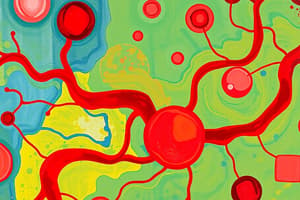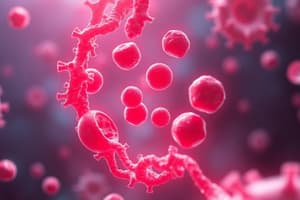Podcast
Questions and Answers
Which of the following does NOT represent a pathway of coagulation?
Which of the following does NOT represent a pathway of coagulation?
- Intrinsic pathway
- Parallel pathway (correct)
- Common pathway
- Extrinsic pathway
What is the primary role of the common pathway in coagulation?
What is the primary role of the common pathway in coagulation?
- To activate the intrinsic factors
- To interact with the immune response
- To form a stable blood clot (correct)
- To initiate the coagulation process
Which statement is true regarding the extrinsic pathway of coagulation?
Which statement is true regarding the extrinsic pathway of coagulation?
- It is the slowest pathway of coagulation.
- Tissue factor is essential for its activation. (correct)
- It operates mainly in the absence of tissue factor.
- It is activated by internal stimuli.
How do the pathways of coagulation interact?
How do the pathways of coagulation interact?
Which of the following best describes the intrinsic pathway of coagulation?
Which of the following best describes the intrinsic pathway of coagulation?
What is the primary role of factor III (tissue factor) in the coagulation process?
What is the primary role of factor III (tissue factor) in the coagulation process?
Which factor is directly activated by both the intrinsic and extrinsic coagulation pathways?
Which factor is directly activated by both the intrinsic and extrinsic coagulation pathways?
Which statement correctly describes the relationship between the extrinsic pathway and factor VII?
Which statement correctly describes the relationship between the extrinsic pathway and factor VII?
What is a defining characteristic of the extrinsic coagulation pathway compared to the intrinsic pathway?
What is a defining characteristic of the extrinsic coagulation pathway compared to the intrinsic pathway?
Which factor is not involved in the final common pathway of coagulation?
Which factor is not involved in the final common pathway of coagulation?
Flashcards
Coagulation
Coagulation
The process of blood clotting, involving a series of steps to form a stable blood clot.
Extrinsic Pathway
Extrinsic Pathway
A pathway in coagulation that begins when damaged tissue releases a protein called tissue factor (TF).
Intrinsic Pathway
Intrinsic Pathway
A pathway in coagulation that begins when blood comes into contact with a foreign surface, like collagen.
Common Pathway
Common Pathway
Signup and view all the flashcards
Factor X
Factor X
Signup and view all the flashcards
Extrinsic Coagulation Pathway
Extrinsic Coagulation Pathway
Signup and view all the flashcards
Intrinsic Coagulation Pathway
Intrinsic Coagulation Pathway
Signup and view all the flashcards
Final Common Pathway
Final Common Pathway
Signup and view all the flashcards
Factor III (Tissue Factor)
Factor III (Tissue Factor)
Signup and view all the flashcards
Study Notes
Anticoagulation and Thrombosis
- Coagulation is a complex process enabling blood to form clots.
- It's a vital part of hemostasis, which stops blood loss from damaged vessels.
- Coagulation disorders can cause bleeding (hemorrhage) or clotting (thrombosis).
Hemostasis Mechanisms
- Hemostasis involves three mechanisms:
- Vascular spasm: Damaged blood vessels constrict.
- Platelet plug formation: Platelets adhere to damaged endothelium forming a plug (primary hemostasis).
- Blood coagulation: Clots form from fibrinogen converting to fibrin (secondary hemostasis).
Coagulation Pathways
- Coagulation involves three pathways: extrinsic, intrinsic, and common.
- These pathways interact to form a stable blood clot.
- The extrinsic pathway is initiated by factor III (tissue factor), interacting with factor VII.
- The intrinsic pathway involves factors XII, XI, IX, and VIII.
- The common pathway uses factors X, V, II, I, and XIII.
Pathway Triggers
- Extrinsic pathway: Release of biochemicals from broken blood vessels/damaged tissue.
- Intrinsic pathway: Blood contacts damaged endothelial layer of blood vessel walls (no tissue damage).
Coagulation Goal
- The main goal is to form a stable clot to stop bleeding and allow tissue repair.
- Coagulation disorders affect the cascade, causing either excessive or inadequate clotting.
- Common coagulation disorders include hemophilia and vitamin K deficiency.
Prothrombin Time (PT/INR) Test
- Measures how quickly blood clots.
- High PT/INR results indicate slower clotting time, potentially due to bleeding disorders, liver problems, or insufficient vitamin K intake.
- Vitamin K is crucial for blood clotting, preventing excessive bleeding.
Anticoagulants
- Anticoagulants prevent or delay blood clotting.
- Common examples include heparin and warfarin which are blood thinners.
- Both types reduce blood clot formation.
Studying That Suits You
Use AI to generate personalized quizzes and flashcards to suit your learning preferences.




